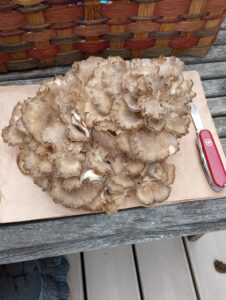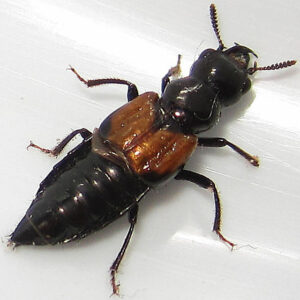APPRECIATING ENDLESS FORMS – September 24, 2023 – By D. Randy Weidner
Like many things in the natural world, the fruiting of mushrooms have a season. Lest you think that now you will learn exactly when to go out and find a particular species of wild mushroom, I am sorry to disappoint. I have long been interested in the fruiting phenology of fungi, and for some time kept careful logs of when I found what mushrooms. I did this with the half selfish idea that it would help make my mushroom foraging easier in my dotage. What actually happened was that the timing of when I found certain species has changed significantly over time.
Morels in our area always fruited in later May, with the 18th being the most productive day. Lately, I find some significantly earlier. August and September were the traditional months for finding the greatest variety of species, and that may still be so, but the range is now clearly July through October. Chanterelles that used to be best around August 1, now fruit in June. Many fall fruiting fungi are still dependably found later in the season; but the dates of ‘later’ are changing.
It is easy to say that climate change is the factor; but there was always much more than temperature involved. The one factor I felt supremely confident about was the effect of rainfall. Many years ago, I read an article in the bulletin of the Boston Mycological Club, one of the oldest amateur mycological associations in the country, that stated if an area received 4 inches of rain over a short period, followed by an inch of rain per week over three successive weeks, there should be good continuous fruiting of mushrooms in summer and fall. I had always found that to be true, until this year. Now I am not so sure.
Given this unpredictability of mushroom fruiting, I am more often disappointed visiting my best spots at the times I expect to find mushrooms. I did well this year with chanterelles, but missed many summer mushrooms and some late summer species, disappointedly finding Chicken of the Woods (Laetiporus sulfureus), and Herricium species like Lion’s Mane and Bears Tooth, too old and dry for eating. So, as the season for Hen of the Woods (aka Maitake, Grifola frondosa) drew near, I visited my old spots more often. Less than a week after checking a known productive oak stump and finding nothing, I returned and harvested a two pound pristine specimen.

With Hen of the Woods, finding a fruiting specimen is worth remembering the location. Conditions being right, whatever that now means, the fungus will fruit yearly in that location for a few years before the mycelium producing the fruiting body exhausts the supply of nutrients it was getting from the host, and dies out. Not only is this a delicious mushroom, it often fruits in good quantity, from the same place for a while, and is a very distinctive fungus, not likely confused with anything toxic.

In harvesting my Hen of the Woods, I carefully cut across the base of the large fungus and placed it in a paper bag. I noticed the cut thick stem of compact mycelium had a few holes about the diameter of a pencil. At home, removing the fungus from the bag, an attractive black and red Cross- toothed Rove Beetle (Oxyporus rufipennis) fell out. Anyone who harvests wild mushrooms often finds invertebrates living on and in the mushrooms, something to cut out or brush off, along with other forest debris, before eating. No surprise there. Cutting up the fungus revealed those holes were tubular tunnels and a few more beetles were hiding inside.
These Cross-toothed Rove Beetles are one of several beetle species living exclusively in fungi. The tunnels are made by the adults as they eat their way through. Adults construct brood chambers in which to mate and lay eggs, which rapidly hatch into beetle grubs that also eat the fungus. These beetles have several very characteristic anatomical features including bead-like antennae, large jagged mandibles for cutting through fungal tissue, and a distinctive labial palpomere, a sensing organ they use to locate fungi.
I have been hunting and eating wild fungi for over 50 years, an old, but not bold, mushroom eater. My time at this activity may seem fairly long, but fossilized in amber from Myanmar, are rove beetles with nearly identical anatomy to present-day Oxyporus species, dating from about 100 million years ago, around the same time mushrooms are assumed to have arisen. So, with competition this long and successful, I am happy for every good mushroom I can get before those other hunters find them.
